In this lab, I learned how to identify minerals by testing their properties. Luster,streak, hardness, cleavage are properties of minerals.Luster is about if a mineral is metallic or nonmetallic. To see if it is metallic, we just need to place a magnet beside the mineral. Streak is about if a mineral is color or colorless/white. To see if it has color, we can scratch it on a streak plate. hardness is about if a mineral is hard or soft. We can scratch it on a glass plate. If it is scratches, its hardness is over 5.5. Cleavage is about if a mineral can be cut evenly. If it is cut unevenly, then it is fracture.
Reflection
1.What did you enjoy most about this project and why?
I enjoy testing the properties of minerals with my partner. It was fun and scientific through studying with partner.
2. What was most challenging for you during this project and why ?
I think doing the lab report is most challenging. Because those paragraphs needed to be in our own words.
3. What new skills did you learn from doing this project ?
I learn how to identify minerals with streak plate and glass plate.
4. Is there anything that you could have done to improve any of your work ? Explain.
I could have made our video better. There were some mistakes when we were taking it. For example, we didn't use penny and nail to test minerals.
IHSL@ Qi Qi Liang ★☆
Tuesday, May 8, 2012
Sunday, April 8, 2012
Shake Shake Shake Our Earth
Layers:
Lithosphere
Activities: Mini Posters, BrainPop Video, Music Videos
Topics: Continental Drift, Faults, Plate Tectonic, Volcanoes, Earthquakes, Earth Structure, Seismic Waves.
Earth has three basic layers: Core, mantle and crust. Crust is the layer that we live on. This is the hard layer under grass, dirt, sand and water. It is thick in the continent and in the ocean basins. Mantle is made up of mixture of element. It is deep and massive, goes down from the bottom of the crust. The upper mantle is soft and plastic which allow the plates move around. The lower mantle is solid and hot. The center of the earth is core, outer core and inner core. Outer core made of molten iron and nickel. It is liquid layer with 2,300 Km thick. Inner core is 5,100 Km below the surface. It spins and along with the convection current in the mantle. Inner core is a hard ball that made of iron.
Asthnosphere
Activities: Foldables & Mini-Quiz,Demonstration Lab
Topics: Continental Drift, Faults
Alfred Wegener thought of the continental drift. He thought that all continents were used to be one supercontinent called Pangaea. It is like a puzzle when you put all continents together. Fossils, rock record and mountain rangers are the evidences of this theory, they can be found all over the world. The surface of land has chance to occur faults. Normal fault is when land moves downward. Reverse/Thrust fault is when land moves upward. Strike-slip fault is when land slide past each other horizontally.
Mantle
Activities: Photographic evidence, Exploration Labs
Topics: Plate boundaries, Subduction Zone, Fault zone, Hot spot, Tsunami, Earthquake
Earth’s crust is broke up into minor plates. Because of the mantle under the crust, plates move around on top of the mantle. When plates moving, they can slide apart, collide together or horizontally past each other. The boundaries where plates meet may cause volcanoes, mountains, trenches and earthquakes. They are also called faults. Because plates build up pressure in side rocks, rocks broke up and shift to release the pressure. This is earthquake. Earthquake has three types of waves. They are P-wave, S-wave and L-wave. earthquake can bring huge damage to the environment. It is serious disaster. Scientists use seismograph which is a machine to measure how big and how long of the quakes.
2. Critical Thinking Question
I agree with the theory of plate tectonics. If we put all continents together, they are look like puzzle. Alfred Wegener thought of the continental drift that all continents were used to be one supercontinent called Pangaea. After millions years, Earth’s crust broke up in large pieces called plates. Plates are moving few centimeters away from each other year by year. Scientists found that rocks record and fossils in continents have similarity. That’s why there are seven continents on the earth.
Because of the convection current, the heat in the mantle forces plates are moving on top of the mantle in different direction. This causes the ocean floor spreading from the center. The boundaries of plates create geological activities when they against each other, such as volcanoes, earthquakes, fault, subduction zone and mountain building.
3. Reflection
1. What did you enjoy most about this project and why?
I enjoyed doing the convection current lab and making the photographic evidence video. I can understand better about how the convection current works through doing the lab. And this is the first time that I made video.
2. What was most challenging for you during this project and why?
This project was not really challenging for me. All I need was have enough time to finish them.
3. What new skills did you learn from doing this project?
I learned to make video and use the lab scale that used to weight stuff from doing this project.
4. Is there anything that you could have done to improve any of your work? Explain.
I could have re-do the lab.There was a human error when we were measuring the basalt and garnet rocks.I could have measured another rocks to see if their result are the same.
Sunday, March 25, 2012
Shaking Our World
Geography | Cause | Effect |
Convergent Boundary | Two plates come together | It creates mountains, trenches, volcanoes and islands. |
Divergent Boundary | Two plates move apart | It creates new ocean crust (sea-floor spreading), mid-ocean ridge and rift valley. |
transform Boundary | Plates slide past each other in opposite direction | It creates faults, earthquakes and tsunami. |
Subduction Zone | A dense plate goes under another less dense plate | It creates volcanoes and trenches. It may also form islands. |
Fault Zone | The region where large fractures in the earth's crust | Faults can cause earthquakes and tsunami. It does damages, such as building collapse. |
Hot Spot | A really part of the mantle, it forces magma up to the surface | It creates islands. |
Earthquake | Occurs mainly at plate boundaries, movement along faults | It destroys the environment, decreases economy and takes people's lives. |
Tsunami | Earthquake occur under the ocean cause huge ocean waves | It brings flooding, takes people's lives. And destroys the environment, decreases economy. |
The boundary between plates called plate boundary. There are three types of plate boundaries which are convergent, divergent and transform boundary. They have different movement and conformation of surficial geography. Convergent boundary is where two plates come together. When two continental plates come together, it forms mountains. When there are oceanic plate and continental plates, it forms subduction zone cause of the dense oceanic plate goes under the continental plate. Volcanoes and trenches are formed at subduction zone. Divergent boundary is where two plates pull apart. It forms mid-ocean ridge between two plates and trenches, mountains, volcanoes. Transform boundary is where plates slide past each other in opposite direction. It causes faults and earthquake. If earthquake occurs under the ocean, it brings tsunami.
Saturday, February 4, 2012
Massive Movement Project
Eclipse
Vocabulary:
Lunar Revolution
月球公转
The moon moves around the earth.

Phase of the Moon
月相
Changing shape of the moon.

Umbra
暗影
The dark part of the shadow.

Penumbra
半影
The light part of the shadow.

Total Eclipse
全食
When the entire sun is covered by the moon.

Partial Eclipse
偏食
When only part of the sun is covered by the moon.

Solar Eclipse
日食
When the moon moves between the sun and earth and blocks the light to earth.
Lunar Eclipse
月食
When the moon moves behind the earth into the shadow.
Summary:
Lunar revolution can cause of eclipses. When the moon moves around the earth in different positions, its movement causes phase of the moon. Umbra is the darkest part of the shadow, when the moon moves in umbra, it will become total eclipse. Penumbra is the light part of the shadow, when the moon moves in penumbra, it will become partial eclipse. Solar eclipse is when the moon moves between the sun and earth and blocks the sunlight to the earth. It happens in daytime. Lunar eclipse is when the moon moves into earth's shadow. It happens in nighttime. Both solar eclipse and lunar eclipse have total/partial eclipse.
Video:
Class M - #3 - 2012 from Kara MacDevitt on Vimeo.
Critical Thinking Question:
How is earth affected by movement(revolution)?
Earth revolution is the earth orbits around the sun. It takes 365 days or 1 year to revolve one time around the sun. It also rotate on its axis for 24 hours in counter-clock wise while it is revolving the sun. Earth is tilted 23.5 degree. Its axis is point to the north star, Polaris. Because the earth rotation so that we have day and night. Earth revolution causes four seasons which are the spring, summer, autumn and winter. And we can see the movement of the stars. Because it is revolve the sun so that the earth receive different sunlight when it is in different position. That is why we have summer/winter solstices and vernal/autumnal equinoxes.
Reflection:
1. What did you enjoy most about this project and why?
I enjoyed working with my group members, learning new things and organizing the props. We helped each other. Sometimes we had argue and sometimes we collaborated well. I liked to see everybody was working on their part.
2. What was most challenging for you during this project and why?
The most challenging for me during this project was when we need to practice and take video. It was hard to keep everything organized while we were taking the video. Even though we already practiced many times, but it still hard to do
3. What new skills did you learn from doing this project?
I learned how to edit the video. Although I was not video editor, but I learned how to make it fancy and more interesting by watching my group member edited it.
4. Is there anything that you could have done to improve any of your work? Explain.
I could have find more props and retake the video. All the stuff were kind of messy in the video, and some props were not in the right position. I think our video could have be more interesting and detailed.
Vocabulary:
Lunar Revolution
月球公转
The moon moves around the earth.
Phase of the Moon
月相
Changing shape of the moon.

Umbra
暗影
The dark part of the shadow.

Penumbra
半影
The light part of the shadow.

Total Eclipse
全食
When the entire sun is covered by the moon.
Partial Eclipse
偏食
When only part of the sun is covered by the moon.

Solar Eclipse
日食
When the moon moves between the sun and earth and blocks the light to earth.
Lunar Eclipse
月食
When the moon moves behind the earth into the shadow.
Summary:
Lunar revolution can cause of eclipses. When the moon moves around the earth in different positions, its movement causes phase of the moon. Umbra is the darkest part of the shadow, when the moon moves in umbra, it will become total eclipse. Penumbra is the light part of the shadow, when the moon moves in penumbra, it will become partial eclipse. Solar eclipse is when the moon moves between the sun and earth and blocks the sunlight to the earth. It happens in daytime. Lunar eclipse is when the moon moves into earth's shadow. It happens in nighttime. Both solar eclipse and lunar eclipse have total/partial eclipse.
Video:
Class M - #3 - 2012 from Kara MacDevitt on Vimeo.
Critical Thinking Question:
How is earth affected by movement(revolution)?
Earth revolution is the earth orbits around the sun. It takes 365 days or 1 year to revolve one time around the sun. It also rotate on its axis for 24 hours in counter-clock wise while it is revolving the sun. Earth is tilted 23.5 degree. Its axis is point to the north star, Polaris. Because the earth rotation so that we have day and night. Earth revolution causes four seasons which are the spring, summer, autumn and winter. And we can see the movement of the stars. Because it is revolve the sun so that the earth receive different sunlight when it is in different position. That is why we have summer/winter solstices and vernal/autumnal equinoxes.
Reflection:
1. What did you enjoy most about this project and why?
I enjoyed working with my group members, learning new things and organizing the props. We helped each other. Sometimes we had argue and sometimes we collaborated well. I liked to see everybody was working on their part.
2. What was most challenging for you during this project and why?
The most challenging for me during this project was when we need to practice and take video. It was hard to keep everything organized while we were taking the video. Even though we already practiced many times, but it still hard to do
3. What new skills did you learn from doing this project?
I learned how to edit the video. Although I was not video editor, but I learned how to make it fancy and more interesting by watching my group member edited it.
4. Is there anything that you could have done to improve any of your work? Explain.
I could have find more props and retake the video. All the stuff were kind of messy in the video, and some props were not in the right position. I think our video could have be more interesting and detailed.
Monday, December 12, 2011
Geologic Time - Neogene Period
Summary
Neogene period was the age of Mammals. Neogene period is in tertiary period of Cenozoic era. The period when first hominids , modern forms of whales became exist. Megalodon is the shark that swam the seas by this time. This period is consisted of 2 Epoch: Pliocene (5-1.8 mya); Miocene (24-5 mya). Miocene is about mammals, bears, horses, monkeys and birds.
Neogene Period.
Project Reflection
1. What did you enjoy most about this project?
I enjoy creating the glog and working with partner, this could help a lot to understand the project. Collaboration is good.
2. What was most challenging about this project? Why?
The most challenging was search the information and write them in own words. I could not understand those professional words. It was hard to find information.
3.What are 3 things that you learned from this project?
I learned that Neogene was the age of mammals. New life was formed in this period, such as sharks, mammoths, bears, etc. And Andes Mountain formed in South America because the movement of tectonic plate. Also high temperature was cause appeared deserts and dry forests in Australia continent.
4. What you change about this project and why?
I do not need to change anything about this project, because my partner and I already changed it many times before. And both of us think that the glog and video is done with careful and detailed.
Extra Credit
Summary
Paleogene was period of made up life in the Earth. The Paleogene consist of 3 epochs: Oligocene, Eocene and Paleocene. New living thing appeared on this period such as first large mammals, deer, pigs, cats, rhinos, tapirs and new form of whales. First whale appeared in Paleocene epoch between 65 and 54 million years ago.
Paleogene Period.
Neogene period was the age of Mammals. Neogene period is in tertiary period of Cenozoic era. The period when first hominids , modern forms of whales became exist. Megalodon is the shark that swam the seas by this time. This period is consisted of 2 Epoch: Pliocene (5-1.8 mya); Miocene (24-5 mya). Miocene is about mammals, bears, horses, monkeys and birds.
Neogene Period.
Project Reflection
1. What did you enjoy most about this project?
I enjoy creating the glog and working with partner, this could help a lot to understand the project. Collaboration is good.
2. What was most challenging about this project? Why?
The most challenging was search the information and write them in own words. I could not understand those professional words. It was hard to find information.
3.What are 3 things that you learned from this project?
I learned that Neogene was the age of mammals. New life was formed in this period, such as sharks, mammoths, bears, etc. And Andes Mountain formed in South America because the movement of tectonic plate. Also high temperature was cause appeared deserts and dry forests in Australia continent.
4. What you change about this project and why?
I do not need to change anything about this project, because my partner and I already changed it many times before. And both of us think that the glog and video is done with careful and detailed.
Extra Credit
Summary
Paleogene was period of made up life in the Earth. The Paleogene consist of 3 epochs: Oligocene, Eocene and Paleocene. New living thing appeared on this period such as first large mammals, deer, pigs, cats, rhinos, tapirs and new form of whales. First whale appeared in Paleocene epoch between 65 and 54 million years ago.
Paleogene Period.
Sunday, November 13, 2011
The Stars
1. What is a star ?
A star is a luminous large ball of hot gas. Because they are light years far away from us, so they look small. But in fact many stars are bigger and brighter than the sun. The center of a star has nuclear fusion to make heat and energy.There are lots of different colors and sizes of stars.
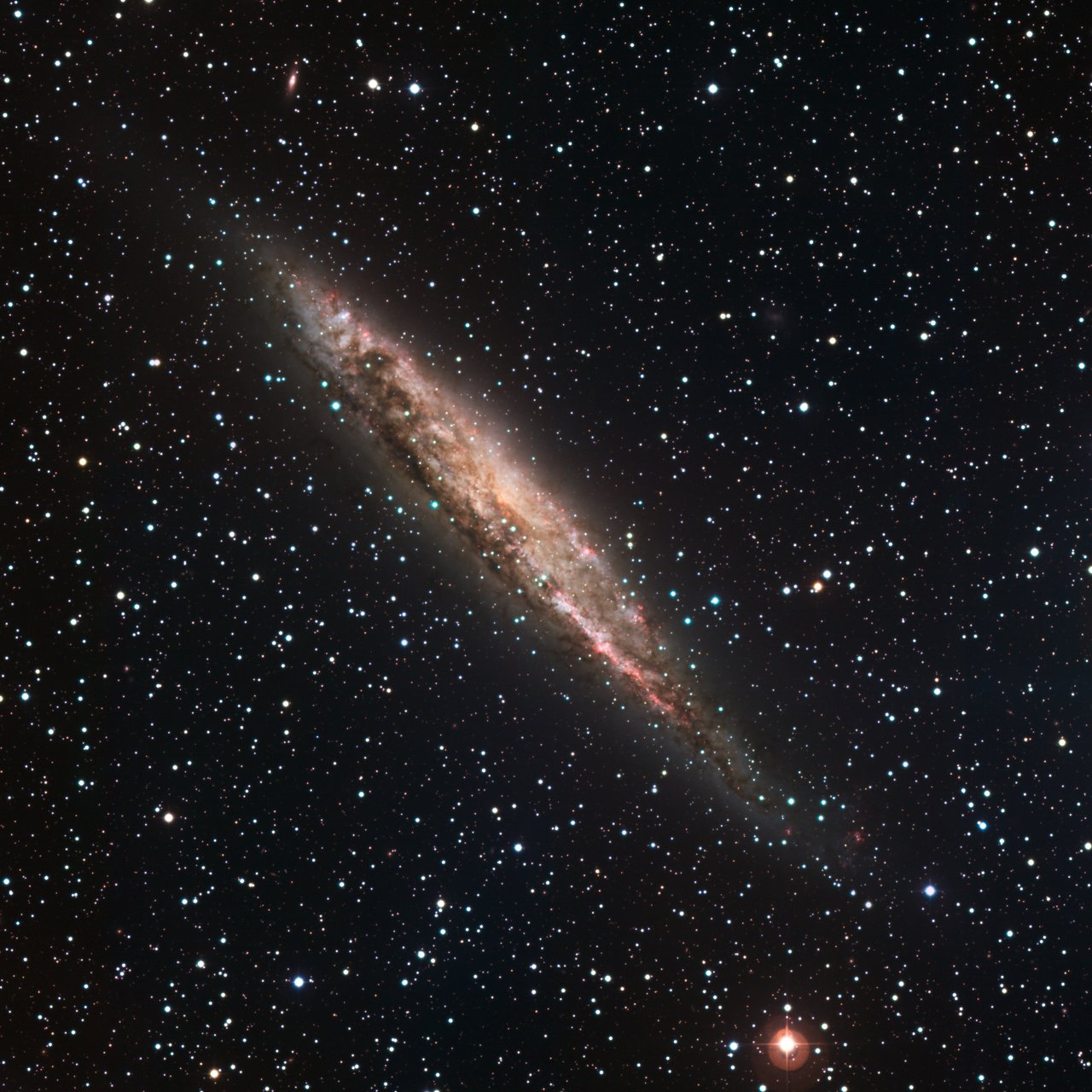
2. Types of Stars
The 4 types of stars: Super Giant, Giant, Main Sequence and White Dwarf. Super Giant stars are large middle age stars, they have medium temperature. Also they are bright stars. Giant stars are large middle age stars. they are irregular range stars on temperature, luminosity and color. Main Sequence stars are medium middle age stars, they are cold and have large range luminosity. White Dwarf are small young stars, they are hot but dim luminous.
3. H-R Diagram
The Hertzsprung - Russell diagram is a graphical tool use to classify stars based on their luminosity, spectral class, color, temperature and evolutionary stage.

4. Nuclear Fusion
Stars are made in giant clouds of dust and gas called a stellar nebula. The gravity cause of the cloud get smaller and it become hotter. When the cloud is hot enough, a star is formed while the nuclear reaction will occur in the middle of the cloud. The nuclear reaction is change two hydrogen gas molecules into a helium molecule to make energy. This process is known as nuclear fusion.

5. The Life Cycle of a Star
There are three types life cycle of a star. They all start from stellar nebula which is a giant cloud with dust and gas. Sun-like stars will become red giant. after that, it will become a cloud of dust and gas called planetary nebula, and then it will become white dwarf. After this, it will turn into a cold, dark object called black dwarf. Huge stars and Giant stars both will become red super giant, after they will pass through a giant explosion called supernova. At the end, huge stars will become a small, dense neutron star and Giant stars will become a dead star called black hole.
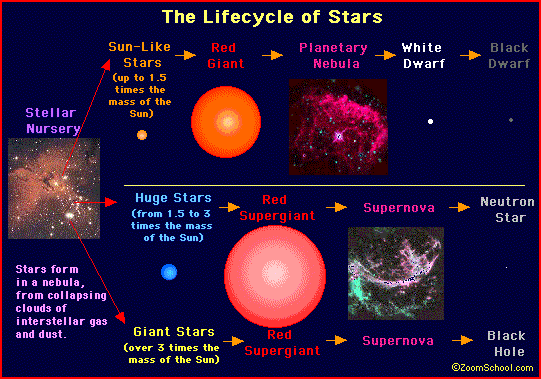
A star is a luminous large ball of hot gas. Because they are light years far away from us, so they look small. But in fact many stars are bigger and brighter than the sun. The center of a star has nuclear fusion to make heat and energy.There are lots of different colors and sizes of stars.

2. Types of Stars
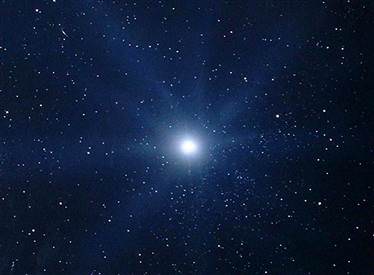 |
| White Dwarf |
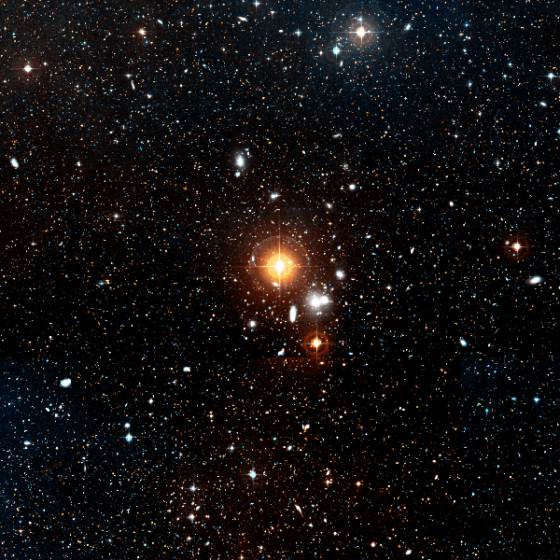 |
| Giant |
 |
| Supergiant |
 |
| Main Sequence |
3. H-R Diagram
The Hertzsprung - Russell diagram is a graphical tool use to classify stars based on their luminosity, spectral class, color, temperature and evolutionary stage.

4. Nuclear Fusion
Stars are made in giant clouds of dust and gas called a stellar nebula. The gravity cause of the cloud get smaller and it become hotter. When the cloud is hot enough, a star is formed while the nuclear reaction will occur in the middle of the cloud. The nuclear reaction is change two hydrogen gas molecules into a helium molecule to make energy. This process is known as nuclear fusion.
5. The Life Cycle of a Star
There are three types life cycle of a star. They all start from stellar nebula which is a giant cloud with dust and gas. Sun-like stars will become red giant. after that, it will become a cloud of dust and gas called planetary nebula, and then it will become white dwarf. After this, it will turn into a cold, dark object called black dwarf. Huge stars and Giant stars both will become red super giant, after they will pass through a giant explosion called supernova. At the end, huge stars will become a small, dense neutron star and Giant stars will become a dead star called black hole.
Tuesday, October 18, 2011
Jupiter
Jupiter
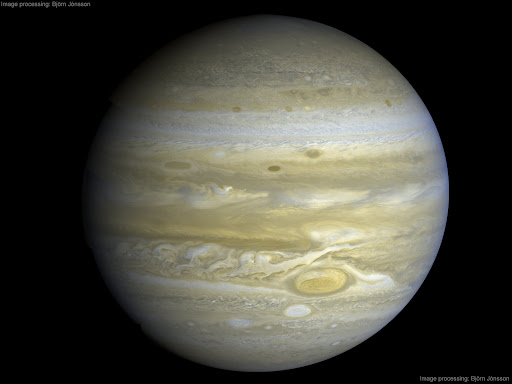
Planet Order: 5 from the Sun
Distance From the Sun: 778.33 million Km
Mass: 1.9x1027 Kg Diameter: 142.984 Km
Rotation: 9hours50mins
Revolution: 11.9 Earth years
# of Moons: 63 Terrestrial or Jovian: Jovian
Planet Description:
Jupiter is the largest planet in the Solar System. Also the home of the largest storm ever observed. Your can see the Great Red Spot on the surface of Jupiter easily. Its wind blow up to 400 Km per hour in it, lightning hundreds of time more powerful than in any Earth storm. Jupiter has 4 major moons: IO, Europa, Callisto, Ganymede and has other small moons. It's mostly hydrogen and helium mixing with ammonia,methane and sulfur to form colorful swirling clouds. Jupiter has a monster magnetic field.
2 Interesting Facts:

Planet Order: 5 from the Sun
Distance From the Sun: 778.33 million Km
Mass: 1.9x1027 Kg Diameter: 142.984 Km
Rotation: 9hours50mins
Revolution: 11.9 Earth years
# of Moons: 63 Terrestrial or Jovian: Jovian
Planet Description:
Jupiter is the largest planet in the Solar System. Also the home of the largest storm ever observed. Your can see the Great Red Spot on the surface of Jupiter easily. Its wind blow up to 400 Km per hour in it, lightning hundreds of time more powerful than in any Earth storm. Jupiter has 4 major moons: IO, Europa, Callisto, Ganymede and has other small moons. It's mostly hydrogen and helium mixing with ammonia,methane and sulfur to form colorful swirling clouds. Jupiter has a monster magnetic field.
2 Interesting Facts:
- Jupiter's volume is large enough to contain 1,300 planets the size of Earth.
- Jupiter rotates faster than any planet in the Solar System so that the days are only 9hours50mins long.
Subscribe to:
Comments (Atom)

